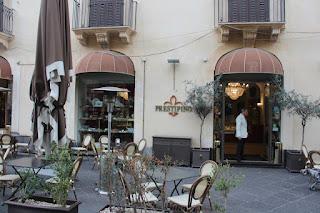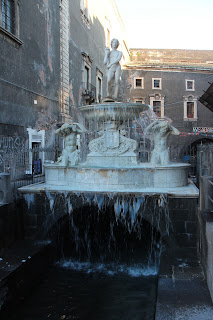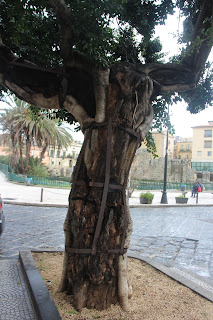No wonder Sicilians flock to Melbourne, the weather is so similar. We are getting used to the rapid changes of weather here: four seasons in one day at times. Though, today it was hot all day. We left home in jackets, but pulled them off even as we walked to the bus stop, and off they stayed all the day.
Sicilian towns are well served by buses. Syracuse--like Palermo, Ragusa, and the inland hill towns we have just left--has a small bus that travels one way around the town perimeter. It completely circles Ortigia, our historic Syracuse island, which is all of one kilometre long and 500 metres wide and stops at many interesting points around the island. A ticket is just €1, valid for 90 minutes. So, if you hop off to have a look at a sight, you might be able to hop on and head for coffee or lunch and still have a valid ticket. We have never waited longer than 5 minutes for a bus. A wonderful service, with excellent simple signage along the route, pointing out the sites that you might find at each stopping point.
Today we took Line 1 across the bridge to modern Syracuse, where we connected with Line 2 which took us right inside the Archeological Park. Our trusty little Line 1 bus quickly filled with oldies who had come down to the fish market near the Ortigia bridge and were now carrying their fresh dinner fish home with them: local seniors riding for free, which is such a good deal for them. I gave up my seat to a sweet old lady, who cheered every time someone gave their seat to an elderly person: male or female. Not that too many young legs use these buses. The walking is far from strenuous on the island, it is a delight: but today we had a destination in mind: the UNESCO Archeological Park on the edge of modern Syracuse and we anticipated needing the day there, so we were motoring.
It took about 30 minutes to get there, we bought our tickets, and started exploring the vast site which has been cordoned off in sections so you see each site in a circle walk. A little too defined for me. I prefer to roam. But, I imagine, with crowds as there would be in the summer, this would keep order, and work.
We avoided the offer of tour guides at the gate as we use on and offline Apps on the phone and iPad these days, which offer all the detail and more, that we need. Even so, those without Apps might have been somewhat befuddled in parts, as there were few information boards posted, and little in the way of directional signage. Still, staff were around most of the venues, helping out where needed.
The three big highlights are the Greek and Roman Amphitheatre, virtually side by side, but built hundreds of years apart, and the Ear of Dionysius, a slot cavern, which has some tales to tell.
We walked through citrus groves that are filling in and gradually softening massive walls cut sheer and vertical in the vast limestone quarry on the edge of the site that had been the main source of much of the stone used around the site. Once it held some 7000 Athenian prisoners of war, after the big Syracuse win. Today, it was filled with the scent of lemons and bird song and was quite lovely.
The Greek amphitheatre was the main attraction for me. It looks today much as it ever did even 2,500 years ago. Great playwrights wrote plays for the masses. Actors were celebrities. Plays were of gods and their accomplishments, tragedies and comedies. Some 15,000 people would come to any session, and be entertained. These days only football is likely to attract that number of spectators in Australia. Much of this theatre was literally carved into the limestone in situ, giving the crowds the beautiful blue Mediterranean as a backdrop, and across that blue blue water they might even have been able to see the Isole di Ortigia: our island home.
Close by, is the Orecchio Di Dionisio, the Ear of Dionysius, a rock cavern, very likely a geologically formed slot cavern eroded out by water, which has such perfect acoustics that tales abound that it was used by the tyrant Dionysius as a prison for his political enemies.
Here, it is said, he eavesdropped on their plots and plans from without, so perfect were the acoustics. While we were circling the site, one of the sightseers treated us to a few beautiful measures of an Italian opera, today. Quite lovely, in this setting. Caravaggio, when he visited, gave the cavern this colourful name.
The Roman amphitheatre is like many others we have seen, though famous for being one of the largest ever constructed. It had the usual equipment rooms and animal tunnels underground along with canals of water leading into and out of the venue: some of which would have been used to clean up the blood and gore after the gruesome gladiatorial events.
This amphitheatre, despite being hundreds of years younger than the beautiful Greek theatre is much less in tact as many of the stones from the Roman site were robbed to build fortifications around Ortigia: the old stones given a new lease of life by the island's Spanish overlords in the sixteenth century.
Afternoon saw us heading home to our cave dwelling at the bottom of the island where we took time out to read on a sign at our door that a famous Sicilian actor was actually born here: Salvo Randone. People keep stopping and taking photos, and now we know why. Tho' we know nothing about the man or his accomplishments.
We seem to have a knack for choosing unusual interesting little abodes.
We live among palazzos dripping with decoration. And others decorated by nature. It is all such a delight.
We shopped for dinner fixings down our tight medieval lane at a humble pop up vegetable stall set up only for a few hours a night in the lane space. Here we bought all the vegetables we needed to accompany our spaghetti con sarde dinner for the giant sum of €1.30: tomatoes, mushrooms and fennel: a big packet full, it was too.
With fresh mandarines pulled from local trees for dessert along with thin slices of the pulp, pith and zest of cedro, an odd mutant-looking lemon fruit that we have discovered on Sicily that is sweeter than lemon, but you eat the firm white thick pith along with the pulp; while thin shaved strips of it, and the zest, enhance any pasta dish. Delicious, all.
 |
| Wonderful bus service, simple signage, easy to follow |
 |
| Typical bus ticket holder |
 |
| This limestone was used to build the amphitheatre in situ |
 |
| The ancient Greek amphitheatre |
 |
| Ear of Dionysius, a rock cavern Dionysius used as a political prison |
 |
| Acoustics so perfect whispers could be eavesdropped |
 |
| Stones were robbed from the much younger Roman amphitheatre to build Ortigia fortifications |
 |
| The old stones were reused by the Spanish overlords in building |
 |
| Our homestay was once the home of a famous Sicilian actor |
 |
| All around are palazzos |
 |
| This palazzo is decorated by nature |
 |
| So romantic in the evening glow |
 |
| Mushrooms, tomato and fennel for supper from a street corner seller |






























































